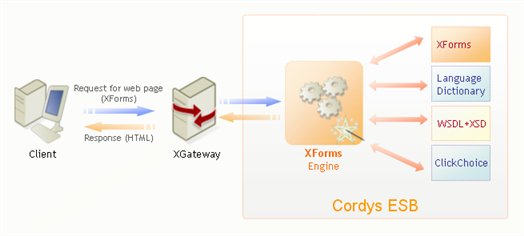Process Platform XForms Architecture |
| This topic describes the architecture of Process Platform XForms. |
|
Process Platform XForms comprises the following components that work together to generate Web pages:
- XForms Client: The client (browser) sends requests and displays responses. It also updates modified data, synchronizes Web pages, and provides navigation between them.
- XForms Gateway: Receives and responds to requests for Web pages (.caf files) from the client.
- XForms Engine: Executes XForm definitions, sets label translation and validation, generates HTML pages, and sends them to the Gateway.
When you open or refresh a Web page, which is an XForm with a .caf extension, the client routes the request to a Web server that identifies the requested file type.
The Web server forwards all requests for .caf files to the XForms Gateway for processing. The Gateway prepares a SOAP request and forwards it to an XForms Engine, which generates HTML content and sends it back to the Gateway. The Gateway, in turn, sends the HTML content to the Web server, and then to the client, which displays the HTML.
This workflow is represented in the following diagram:

Depending on your requirements, the XForms engine also performs the following tasks while generating HTML:
- It translates the labels that are displayed on the Web page into the specified language.
- It sets validation rules for controls on a Web page using the XSD.
- It caches the generated HTML to ensure faster response.
- It generates SOAP requests based on WSDLs of the Web service operations used.
- It embeds ClickChoice definitions.
